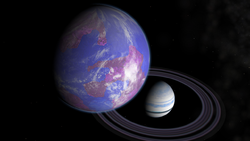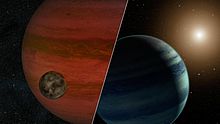系外衛星

系外衛星泛指在系外行星周圍依照閉合軌道做週期性運行的衛星,雖然目前人類尚未發現任何系外衛星,但是理論上應該有許多衛星運行在系外行星周圍。不過要偵測到系外衛星是非常困難的[1]。
褐矮星衛星的定義[編輯]
| 此章節翻譯品質不佳,原文在en:Extrasolar moon。 |
傳統定義指出衛星是在行星周圍依照閉合軌道做週期性運行的天體,但是天文學家在褐矮星周圍發現行星大小的衛星,造成行星與衛星之間的分際相當模糊,因為褐矮星這種低質量的天體被視為失敗的恆星。為了避免造成混亂,國際天文學聯合會宣布:「真實質量低於進行氘核融合質量的天體,該軌道上的恆星或恆星殘餘物視為行星。[2]」根據天文學家的計算,天體要氘核融合質量要達到木星質量的13倍以上,群眾為對象的太陽 金屬量。國際天文學聯合會的定義指出,天體質量比這個下限還小被視為一顆行星,不論它們是如何形成。
特徵[編輯]
天文學家尚未發現任何系外衛星,因此它們的物理性質仍是一個未知數。然而,它們彼此之間的差異可能很大,就像太陽系裡面的衛星一樣。如果系外巨行星位於可居住區裡面的話,它的大型衛星可能可以維持生命存在。
軌道傾角[編輯]
對於距離恆星不太遠的類地行星的撞擊產生的衛星,由於恆星的潮汐作用,預計衛星的軌道平面將傾向於與行星圍繞恆星的軌道對齊,但如果行星-月球距離較小,則可能傾斜。對於氣態巨行星來說,衛星的軌道將傾向於與這顆巨行星的赤道對齊,因為它們形成於環繞行星的圓盤中。[3]
靠近恆星的行星周圍缺少衛星[編輯]
在圓形軌道上靠近恆星的行星會輕視並潮汐鎖定。當行星的旋轉速度減慢時,行星的同步軌道半徑從行星向外移動。對於潮汐鎖定在恆星上的行星,月球繞行星同步軌道的距離在行星的希爾球之外。這顆行星的山丘球體是它的引力支配恆星引力的區域,因此它可以抓住它的衛星。行星同步軌道半徑內的衛星將螺旋進入行星。因此,如果同步軌道在山球之外,那麼所有的衛星都會螺旋進入行星。如果同步軌道不是三體問題,那麼在這個半徑之外的衛星在到達同步軌道之前將逃離軌道。[3]
潮汐引起的遷移研究為這一現象提供了一個可行的解釋。研究表明,主行星的物理演化(即內部結構和大小)對其最終命運起著重要作用:同步軌道可能成為瞬變狀態,衛星很容易在半漸近半長軸上停滯,甚至從系統中彈出,在那裡會出現其他影響。反過來,這將對系外衛星的探測產生重大影響。[4]
觀測方法[編輯]

雖然天文學家尚未發現任何系外衛星,但是理論上許多系外行星都應該擁有衛星[5]。儘管行星獵人利用都普勒光譜法來發現許多系外行星[6],但是無法利用這種技術來系外衛星。這是因為行星與衛星造成的恆星光譜的轉移,將會以一個點在軌道上的移動,所以無法分辨出行星與衛星。因此天文學家將會用下列幾種方式來偵測系外衛星:
凌日時間影響[編輯]
倫敦大學學院的天文學家大衛·基平(David Kipping)在2009年發表了一篇文章[7][1],概述天文學家如何觀測衛星穿越行星時產生的變化。在後續的研究中,大衛·基平與其他天文學家認為克卜勒太空望遠鏡可以偵測到位於適居帶的系外衛星[8]。
照相法[編輯]
要對系外衛星直接拍攝照片是極具挑戰性任務,比對系外行星更難,因為衛星的亮度及大小都不及行星。小型的系外衛星更是難以使用這個方法偵測到。
凌日法[編輯]
當系外行星通過主星前面的時候,天文學家可以觀測到恆星的光度產生小幅度的下降。這種現象也被稱為掩星,與行星的半徑成正比例變動。如果行星及衛星通過主星的前面,它們都會對於恆星的光度產生影響[9]。當它們通過主星的前面時可能會出現行星-衛星蝕[10],但這種情況的概率相對較低。
微引力透鏡[編輯]
韓國天文學家在2002年建議利用微引力透鏡來探測系外行星附近的衛星[11] 。研究人員發現偵測衛星在透鏡光度曲線中的信號非常困難,因為信號的來源有限而被嚴重模糊,而恆星的半徑角度過小也造成阻礙。 人馬座中一顆恆星明亮的瞬間 —微引力透鏡 ,但目前還沒被確認 MOA-2011-BLG-262 .
都普勒光譜法[編輯]
天文學家已經成功利用都普勒光譜法辨識出幾顆系外行星,包括HD 189733 b與HD 209458 b。天文學家偵測到的光譜質量明顯比恆星光譜更受到雜訊的影響。光譜解析度及接收到的光譜特徵所需要的水準遠低於天文學家對於系外行星進行都普勒光譜法所需的水準。
脈衝星計時法[編輯]
澳大利亞蒙納士大學的天文學家劉易斯、薩基特及Mardling[12] 在2008年提出使用脈衝星計時法來探測脈衝星行星的衛星。作者們運用他們的方法對PSR B1620-26 b進行偵測,並發現一個衛星可以穩定存在的區域,如果衛星的軌道距離行星為行星公轉軌道的五十分之一,質量為行星5%以上。
候選行星[編輯]

據推測,位於半人馬座的恆星1SWASP J140747.93-394542.6可能有一顆帶衛星的行星。[13] 確認的太陽系外行星WASP-12b也可能擁有一個月球。[14]

2013年12月,MOA-2011-BLG-262的一顆候選系外衛星被宣布,但由於微透鏡事件建模的退化,觀測結果也可以解釋為海王星質量行星繞著一顆低質量紅矮星運行,作者認為這種情況更有可能發生。[16][17][18] 幾個月後的2014年4月,這個候選行星也出現在新聞中。
2018年10月,研究人員利用哈勃太空望遠鏡發表了對候選系外衛星克卜勒1625b I的觀測結果,這表明宿主行星可能有幾個木星質量,而系外衛星的質量和半徑可能與海王星相似。這項研究得出結論,外月假說是對現有觀測結果最簡單和最好的解釋,儘管它警告說,很難對其存在和性質給出精確的概率。[19][20]
列表[編輯]
| 行星的主恆星 | 行星名稱 | 行星質量 (MJ) |
行星半長軸(AU) | 衛星半長軸 | 衛星質量 (M⊕) |
注釋 |
|---|---|---|---|---|---|---|
| 1SWASP J140747.93-394542.6 | J1407b[21] | 14–26 | 2.2–5.6 | 0.24 AU | <0.3 | 兩個可能的衛星位於J1407b附近的小環隙中。 |
| 0.25 AU | ||||||
| 0.40 AU | <0.8 | 可能的衛星位于于J1407b附近的大環隙中。 | ||||
| HD 189733 | HD 189733 b | 1.13 | 0.031 | 16 RP | ? | 通過研究HD 189733 b發出的光周期性的增加和減少而發現。在行星的希爾球之外。[22] |
| 克卜勒1625 | 克卜勒1625b | <11.6[23] | 0.98 | 45 RP | 10 | 可能是海王星大小的外月或雙行星,由過境觀測表明。[24][25] |
| N/A | MOA-2011-BLG-262L[26] | 3.6 | N/A | 0.13 AU | 0.54 | 由微透鏡發現的;然而,還不知道這個系統是一個圍繞自由漂浮行星運行的次地球質量的系外衛星,還是一個圍繞低質量紅矮星運行的海王星質量的行星。[27] |
| N/A | MOA-2015-BLG-337L | 9.85 | N/A | 0.24 AU | 33.7 | 由微透鏡發現的;然而,還不知道這個系統是一個圍繞自由漂浮行星運行的超級海王星質量行星,還是一個雙星褐矮星系統。[28] |
| WASP-12 | WASP-12b[29] | 1.465 | 0.0232 | 6 RP | 0.57–6.4[來源請求] | 通過研究WASP-12b發出的光周期性的增加和減少而發現。在行星的希爾球之外。[22] |
| WASP-49 | WASP-49b | 0.37 | 0.0379 | ? | ? | WASP-49b周圍的鈉膜可能是由一個類似於木衛一的衛星造成的。[30] |
檢測項目[編輯]
作為克卜勒任務的一部分,克卜勒搜尋系外衛星(HEK)項目旨在探測外衛星。[31][32]
適居性[編輯]
目前至少有兩篇刊發在同行審閱的期刊上的論文研究了系外衛星的適居性。René Heller & Rory Barnes[33] 討論了恆星和行星(母星的熱輻射及反射光)對衛星的光照影響,以及衛星蝕對平均軌道表面的照明影響。同時還討論了潮汐加熱對適居性的威脅。在論文的第四節,作者引入了新概念來定義衛星的適居軌道。提到了環繞行星的適居帶,作者將圍繞某個行星的適居衛星內邊界稱為環繞行星的「適居邊緣」,內適居邊界由總光照(行星和恆星)和潮汐加熱的效果決定。超過適居邊緣的衛星無法擁有生命。在第二個研究中,René Heller [34] 還探討了蝕和衛星軌道穩定性對系外衛星適居性的影響。他發現,根據衛星軌道偏心率的不同,適居衛星所在行星系的恆星的質量至少要為0.2倍的太陽質量。
參考資料[編輯]
- ^ 1.0 1.1 Kipping D. M. Transit timing effects due to an exomoon. Monthly Notices of the Royal Astronomical Society. 2009, 392 (3): 181–189. doi:10.1111/j.1365-2966.2008.13999.x.
- ^ Position statement on the definition of a planet by the International International Astronomical Union. International Astronomical Union. November 12, 2008 [2008-11-11].[永久失效連結]
- ^ 3.0 3.1 Moon formation and orbital evolution in extrasolar planetary systems-A literature review 網際網路檔案館的存檔,存檔日期14 March 2014., K Lewis – EPJ Web of Conferences, 2011 – epj-conferences.org
- ^ Alvarado-Montes J. A.; Zuluaga J.; Sucerquia M. The effect of close-in giant planets' evolution on tidal-induced migration of exomoons. Monthly Notices of the Royal Astronomical Society. 2017, 471 (3): 3019–3027. Bibcode:2017MNRAS.471.3019A. arXiv:1707.02906
 . doi:10.1093/mnras/stx1745.
. doi:10.1093/mnras/stx1745.
- ^ Canup, R. & Ward, W. A common mass scaling relation for satellite systems of gaseous planets. Nature. 2006, 441 (7095): 834–839 [2011-02-15]. PMID 16778883. doi:10.1038/nature04860. (原始內容存檔於2007-09-29).
- ^ The Exoplanet Catalogue. Jean Schneider. November 11, 2008 [2008-11-11]. (原始內容存檔於2010-01-07).
- ^ Hunting for Exoplanet Moons. Centauri Dreams. November 11, 2008 [2008-11-11]. (原始內容存檔於2011-05-19).
- ^ Kipping D. M., Fossey S. J. & Campanella G. On the detectability of habitable exomoons with Kepler-class photometry. Monthly Notices of the Royal Astronomical Society. 2009, 400: 398–405. doi:10.1111/j.1365-2966.2009.15472.x.
- ^ Simon A., Szatmary, K. & Szabo Gy. M. Determination of the size, mass, and density of exomoons from photometric transit timing variations. 天文與天體物理學報. 2007, 480 (2): 727–731.
- ^ Cabrera J. & Schneider J. Detecting companions to extrasolar planets using mutual events. 天文與天體物理學報. 2007, 464 (3): 1133–1138. doi:10.1051/0004-6361:20066111.
- ^ Han C. & Han W. On the Feasibility of Detecting Satellites of Extrasolar Planets via Microlensing. 天文物理期刊. 2002, 580 (1): 490–493. doi:10.1086/343082.
- ^ Lewis K. M., Sackett P. S. & Mardling R. A. Possibility of Detecting Moons of Pulsar Planets through Time-of-Arrival Analysis. 天文物理期刊文章. 2008, 685 (2): L153–L156. doi:10.1086/592743.
- ^ Saturn-like ring system eclipses Sun-like star. [9 March 2018]. (原始內容存檔於19 September 2016). – "Mamajek thinks his team could be either observin行g the late stages of planet formation if the transiting object is a star or brown dwarf, or possibly moon formation if the transiting object is a giant planet"
- ^ Российские астрономы впервые открыли луну возле экзопланеты 網際網路檔案館的存檔,存檔日期10 March 2012. (in Russian) – "Studying of a curve of change of shine of WASP-12b has brought to the Russian astronomers unusual result: regular splashes were found out.<...> Though stains on a star surface also can cause similar changes of shine, observable splashes are very similar on duration, a profile and amplitude that testifies for benefit of exomoon existence."
- ^ Hubble finds compelling evidence for a moon outside the Solar System – Neptune-sized moon orbits Jupiter-sized planet. www.spacetelescope.org. [4 October 2018]. (原始內容存檔於2020-08-07).
- ^ Bennett, D.P.; et al. A Sub-Earth-Mass Moon Orbiting a Gas Giant Primary or a High Velocity Planetary System in the Galactic Bulge. The Astrophysical Journal. 2014, 785 (2): 155. Bibcode:2014ApJ...785..155B. arXiv:1312.3951
 . doi:10.1088/0004-637X/785/2/155.
. doi:10.1088/0004-637X/785/2/155.
- ^ Clavin, Whitney. Faraway Moon or Faint Star? Possible Exomoon Found. NASA. 10 April 2014 [10 April 2014]. (原始內容存檔於12 April 2014).
- ^ First exomoon glimpsed – 1800 light years from Earth. New Scientist. [20 December 2013]. (原始內容存檔於20 December 2013).
- ^ Teachey, Alex; et al. HEK VI: On the Dearth of Galilean Analogs in Kepler and the Exomoon Candidate Kepler-1625b I. The Astronomical Journal. 2017, 155 (1). 36. Bibcode:2018AJ....155...36T. arXiv:1707.08563
 . doi:10.3847/1538-3881/aa93f2.
. doi:10.3847/1538-3881/aa93f2.
- ^ Teachey, Alex; et al. Evidence for a large exomoon orbiting Kepler-1625b. Science Advances. 2018, 4 (10): eaav1784. Bibcode:2018SciA....4.1784T. PMC 6170104
 . PMID 30306135. arXiv:1810.02362
. PMID 30306135. arXiv:1810.02362  . doi:10.1126/sciadv.aav1784.
. doi:10.1126/sciadv.aav1784.
- ^ 1SWASP J1407 b. Extrasolar Planets Encyclopaedia. exoplanet.eu. [1 February 2015]. (原始內容存檔於1 February 2015).
- ^ 22.0 22.1 Ben-Jaffel, Lotfi; Ballester, Gilda. Transit of Exomoon Plasma Tori: New Diagnosis. The Astrophysical Journal. 3 April 2014, 785 (2): L30. Bibcode:2014ApJ...785L..30B. arXiv:1404.1084
 . doi:10.1088/2041-8205/785/2/L30.
. doi:10.1088/2041-8205/785/2/L30.
- ^ Timmermann, Anina; et al. Radial velocity constraints on the long-period transiting planet Kepler-1625 b with CARMENES. Astronomy & Astrophysics. 29 January 2020, 635: A59. Bibcode:2020A&A...635A..59T. arXiv:2001.10867
 . doi:10.1051/0004-6361/201937325.
. doi:10.1051/0004-6361/201937325.
- ^ Drake, Nadia. Weird giant may be the first known alien moon – Evidence is mounting that a world the size of Neptune could be orbiting a giant planet far, far away.. National Geographic Society. 3 October 2018 [4 October 2018]. (原始內容存檔於2020-06-22).
- ^ Teachey, Alex; Kipping, David M. Evidence for a Large Exomoon Orbiting Kepler-1625b. Science Advances. 4 October 2018, 4 (10): eaav1784. Bibcode:2018SciA....4.1784T. PMC 6170104
 . PMID 30306135. arXiv:1810.02362
. PMID 30306135. arXiv:1810.02362  . doi:10.1126/sciadv.aav1784.
. doi:10.1126/sciadv.aav1784.
- ^ MOA-2011-BLG-262. Extrasolar Planets Encyclopaedia. exoplanet.eu. [1 February 2015]. (原始內容存檔於1 February 2015).
- ^ Bennett, D.P.; et al. A Sub-Earth-Mass Moon Orbiting a Gas Giant Primary or a High Velocity Planetary System in the Galactic Bulge. The Astrophysical Journal. 13 December 2013, 785: 155. Bibcode:2014ApJ...785..155B. arXiv:1312.3951
 . doi:10.1088/0004-637X/785/2/155.
. doi:10.1088/0004-637X/785/2/155.
- ^ Miyazaki, S.; et al. MOA-2015-BLG-337: A Planetary System with a Low-mass Brown Dwarf/Planetary Boundary Host, or a Brown Dwarf Binary. The Astronomical Journal. 24 July 2018, 156 (3): 136. Bibcode:2018AJ....156..136M. arXiv:1804.00830
 . doi:10.3847/1538-3881/aad5ee.
. doi:10.3847/1538-3881/aad5ee.
- ^ WASP-12 b. Extrasolar Planets Encyclopaedia. exoplanet.eu. [1 February 2015]. (原始內容存檔於1 February 2015).
- ^ Oza, Apurva V.; Johnson, Robert E.; Lellouch, Emmanuel; Schmidt, Carl; Schneider, Nick; Huang, Chenliang; Gamborino, Diana; Gebek, Andrea; Wyttenbach, Aurelien; Demory, Brice-Olivier; Mordasini, Christoph; Saxena, Prabal; Dubois, David; Moullet, Arielle; Thomas, Nicolas. Sodium and Potassium Signatures of Volcanic Satellites Orbiting Close-in Gas Giant Exoplanets. The Astrophysical Journal. 2019-08-28, 885 (2): 168. Bibcode:2019ApJ...885..168O. arXiv:1908.10732
 . doi:10.3847/1538-4357/ab40cc.
. doi:10.3847/1538-4357/ab40cc.
- ^ Lozano, Sharon; Dunbar, Brian. NASA Supercomputer Assists the Hunt for Exomoons. NASA. 30 January 2015 [31 January 2015]. (原始內容存檔於1 February 2015).
- ^ Nesvorny, David; et al. The Detection and Characterization of a Nontransiting Planet by Transit Timing Variations. Science. June 2012, 336 (6085): 1133–1136. Bibcode:2012Sci...336.1133N. CiteSeerX 10.1.1.754.3216
 . PMID 22582018. arXiv:1208.0942
. PMID 22582018. arXiv:1208.0942  . doi:10.1126/science.1221141.
. doi:10.1126/science.1221141.
- ^ Heller, René; Rory Barnes. Exomoon habitability constrained by illumination and tidal heating. Astrobiology (Mary Ann Liebert, Inc.). January 2013, 13 (1): 18–46. Bibcode:2012arXiv1209.5323H. arXiv:1209.5323
 . doi:10.1089/ast.2012.0859.
. doi:10.1089/ast.2012.0859.
- ^ Heller, René. Exomoon habitability constrained by energy flux and orbital stability. Astronomy and Astrophysics. 2012年9月, 545: L8 [2020-09-16]. Bibcode:2012A&A...545L...8H. arXiv:1209.0050
 . doi:10.1051/0004-6361/201220003. (原始內容存檔於2019-04-23).
. doi:10.1051/0004-6361/201220003. (原始內容存檔於2019-04-23).
外部連結[編輯]
| 維基共享資源上的相關多媒體資源:系外衛星 |
- Shadow Moons: The Unknown Sub-Worlds that Might Harbor Life (頁面存檔備份,存於網際網路檔案館)
- Likely First Photo of Planet Beyond the Solar System(頁面存檔備份,存於網際網路檔案館)
- Working Group on Extrasolar Planets - Definition of a "Planet" Position statement on the definition of a planet. (IAU)
| |||||||||||||||||||||||||||||||||||||||||||||||||||||||||||||||||||||||||||||||||||

